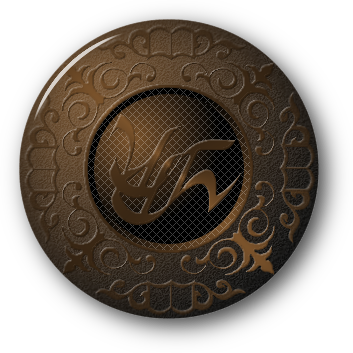D'ni units for measuring compass directions were very different from ours, although they did use the same basic compass points. There are two examples of a D'ni compass rose in Douglas Sharper's office in Teledahn. The first is the rug on the floor, which is in poor condition.
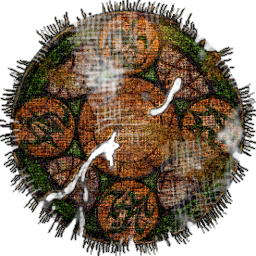
The second example are the hanging lamps in the office, which have the same design in different colors. Here's the bottom half of one of the lamps laid out flat.
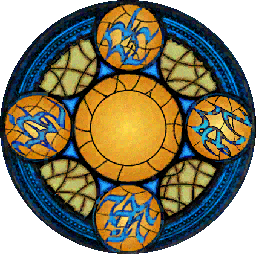
Both examples have monogrammed versions of the words for the cardinal directions: rema rema (north); vamo vamo (east); tēma, tEma (south); and sāra sAra (west).
The base unit for measurement of an arc of a circle was the toran toran, and there were 62,500 torantē in a complete circle.
Standard compasses use 360 degrees for a complete circle. Each degree is divided into 60 minutes. Each minute is divided into 60 seconds. (21,600 minutes / 1,296,000 seconds total.) It should be noted that seconds are too small a unit for accurate measurement by the naked eye and are primarily used on the global scale.
Military compasses in the USA use 6,400 mils for a complete circle. Military organizations in other countries may have different systems with more or less units of measurement.
Distance was measure in shafētē. A shafē SafE is usually translated as a span in English, and equals 13.33 feet (4.064 meters).
I have not yet found references for units of distance greater than or less than a shafē, although they must have existed.
The D’ni’s largest amount of time is a har. A har is roughly equivalent to one year.
Hartē are divided into ten equal segments called valētē. A valē is roughly equal to a month.
Valētē are divided into twenty-nine yartē. A yar is equal to about thirty hours and fourteen minutes (1.26 Earth days). There are 290 yartē in one har.
Yartē are divided into five equal segments called gartavotē. A gartavo equals about six hours and three minutes.
Gartavotē are divided into five equal segments called partavotē. A partavo equals about one hour and thirteen minutes. D'ni timepieces usually show partavotē. There are typically twenty-five partavotē on a D’ni clock, equalling the length of their day.
Partavotē are divided into five equal segments called tavotē. A tavo equals about fourteen and a half minutes.
Tavotē are divided into twenty-five equal segments called gorantē. One goran equals about thirty-five seconds.
Gorantē are divided into twenty-five equal segments called prorantē. One proran is equal to about one and a half seconds.
| Name |
D'ni |
Division |
Translates to |
Hr:Min:Sec |
| har |
har |
- |
Year |
(?) |
| valē |
vAlE |
10 = har |
Month |
(?) |
| yar |
yar |
29 = vale |
Day |
30:14:00 |
| gartavo |
gartavo |
5 = yar |
n/a |
06:03:00 |
| partavo |
partavo |
5 = gartavo |
Hour |
01:13:00 |
| tavo |
tavo |
5 = partavo |
1/4 hour |
00:14:30 |
| goran |
goran |
25 = tavo |
1/2 minute |
00:00:35 |
| proran |
proran |
25 = goran |
Second |
00:00:01:30 |
This is an example of a D'ni clock that was used by Kadish in Ahnonay. The numbers from one to twenty-five represent pahrtahvotē. Further examples of the clock face can be found in the neighborhood classrooms. Note that the numbers progress in what we would consider counter-clockwise order, beginning to the right of the book symbol on the bottom of the number ring.
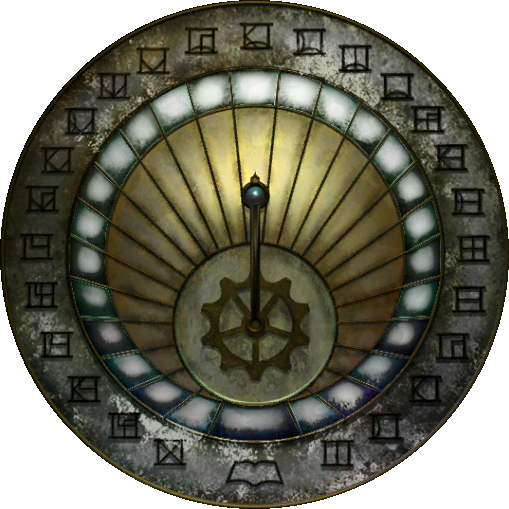
The same basic pattern, formed into a globe, is used for the rotating sphere clocks used in the neighborhoods, and which can be added to an explorer's Relto. The number seen in the magnifying glass is the time, in this case it's just coming up on the fourteenth pahrtahvo. Since a D'ni day is about 30 and ¼ hours, the time shown on a D'ni clock has no relation to surface time.
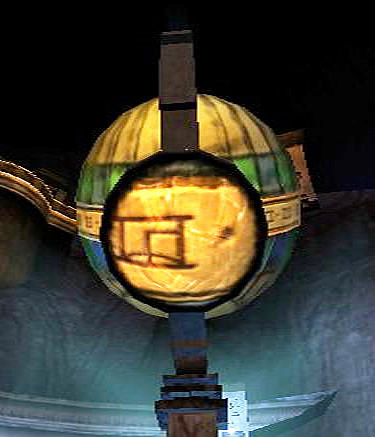 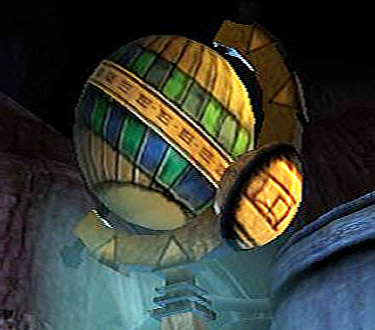
The D'ni year was divided into ten valē ( vAlE ). Their names consist of "lē-", which is a short form of "valē", followed by an alternative form of ordinal number meaning "first, second, third, fourth," etcetera. Thus, the name "lēfo" translates as "first month".
| Month |
Name |
D'ni |
| First |
lēfo |
lEfo |
| Second |
lēbro |
lEbro |
| Third |
lēsan |
lEsan |
| Fourth |
lētar |
lEtar |
| Fifth |
lēvot |
lEvot |
| Sixth |
lēvofo |
lEvofo |
| Seventh |
lēvobro |
lEvobro |
| Eighth |
lēvosan |
lEvosan |
| Ninth |
lēvotar |
lEvotar |
| Tenth |
lēnovū |
lEnovU |
There are a number of known holidays that were observed by the D'ni at the time of the Fall. They were:
New Year's Day - Lēfo 1, April 21
First Feast of the Maker - Lēnovū 10, March 27 (Pre-earth celebration)
The Opening of the Common Library - Lēfo 12, May 5
Second Feast of the Maker - Lēbro 20, June 21 (Pre-earth celebration)
The Day of Dancing - Lētar 21, September 3
First Arrival of the Great King - Lēvot 12, September 28
Third Feast of the Maker - Lēvofo 18, November 11 (Pre-earth celebration)
Coronation of King Kerath - Lēvofo 27, November 23
First Arrival of the Great King
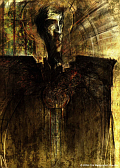 This painting of Ahlsendar, entitled "The Great King" by and painted by Fahlee (DE 2840-3123), can be seen in the Ae’gura Museum. This painting of Ahlsendar, entitled "The Great King" by and painted by Fahlee (DE 2840-3123), can be seen in the Ae’gura Museum.
Only the stone, while they pass beneath, listens to his cries and comforts her fear. Only the Arch welcomes the reign of the great one who guides us.
Those were the words of the prophecy written by Oorpah long before the D’ni came to Earth. As a result, the Arch of Kings — a duplicate of the Arch of Kings on Garternay — was completed in 625 DE. Every King thereafter began his reign by sailing under the massive structure, in hopes that he was the one.
In 1323, during the initial stages of the Pento War, King Koreen and his family were forced to flee, attacked by the Pento. The rumors said that while they fled to the private island that held their only protected Linking Book, Koreen’s wife gave birth to their only child, a son named Ahlsendar, literally as they passed under the Arch. In later years, many of Ahlsendar’s followers claimed that his birth was the fulfillment of that ancient prophecy.
In 1352, Ahlsendar would sail through the Arch again, this time on his way to reclaiming the government of D’ni and putting an end to the Pento War and the first major enemy of D’ni. It was for ending the war and beginning a new way of life that the D’ni called him Great.
While there was also controversy during his reign, on this day — the day the D’ni chose to remember his coming to reclaim D’ni — we choose to remember why they called him the Great King.
The Finding of the Lost Books of Birenni
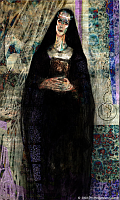 This painting of Lalen can be seen in the Ae’gura Museum. This painting of Lalen can be seen in the Ae’gura Museum.
The days were dark for the people of D’ni as the sickness killed so many, especially the young. Many Ages were written for the Guild of Healers, specifically in hopes of finding a cure for the disease somewhere else, but to no avail. Their King Benashiren was even taken by the plague and finding no suitable heirs, left the throne to his uncle, Hemelin of the Guild of Healers. It was the Healers the public blamed for the sickness and at his coronation there was great sorrow and despair…
Angered at the lack of hope and faith of his people, Hemelin was determined to not only find a cure for his people, but also to return respect to his Guild. Convinced that a cure in one of the Healer Guild Ages, he had long encouraged the Healers to search them all. Now that he was King, he gave them no choice.
Hemelin too soon found himself ill and death was predicted. However, while on his death bed, he met the woman Lalen and a new love began to grow. This new love forged a new will to live and Hemelin eventually recovered as some were fortunate enough to do.
It was Lalen who discovered evidence of old Books to forgotten Healer Ages, and clues to their whereabouts that led to their discovery. In particular, one of these lost Books written by Birenni had provided Hemelin with the plant that would prove to be the cure. Six years later, led by Guild Master Jaysem of the Guild of Healers, and directed by King Hemelin, the plague was officially defeated. King Hemelin wed Lalen on that day and the celebration was unmatched. From that day forward, for many years, the celebrations were grand.
In later years, though still a day that many chose to wed, the day became known for the fire marble search. Fire marbles were hidden in homes and Ages throughout D’ni and the children were sent on searches for the marbles, reminding D’ni of the search of Lalen and Hemelin to find the cure for their people.
King Kerath
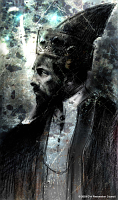 This painting of Kerath can be seen in the Ae’gura Museum. This painting of Kerath can be seen in the Ae’gura Museum.
Thirty-one years after banishing his own son from his palace, as the legend told, King Rikooth was on his deathbed. He was staring out towards the Arch and he saw his son Kerath sailing through it. He was riding a boat in the shape of a massive lizard, standing proudly on its prow and had come home to announce the death of his mother. Rikooth’s heart was changed and a new heir was chosen.
It was a divided society Kerath inherited, breaking at the seams: a population as large as it had ever been and religious, philosophical, and government views as distrinct and numerous as the Ages they had written. Classes had formed, dividing the rich from the poor and the Guild elite from the store merchants.
D’ni had evolved for the better and Kerath sought to push them further. He had decided from an early age that the ways of the Kings were no longer proper for his people. "D'ni is the Guilds… let us be protected by their fortress and be ruled by their wisdom," he argued, claiming to have seen the destructive power of a King firsthand
A new Guild Hall was constructed, more elaborate and elegant than any structure D’ni had ever seen. New Councils were called and Kerath fought for a new leadership, a new vision, and a new branch for his people. In 6977, the last King of D’ni abdicated his throne, becoming the only King to leave his throne of power while still alive, ushering in the time of the Lords.
Just as the Arch renamed after him still stands over the city he once ruled, so does the name of Kerath stand above the other Kings. Perhaps not the greatest, he was the last: the final King to ever rule D’ni and for that he will forever be remembered. |
|
